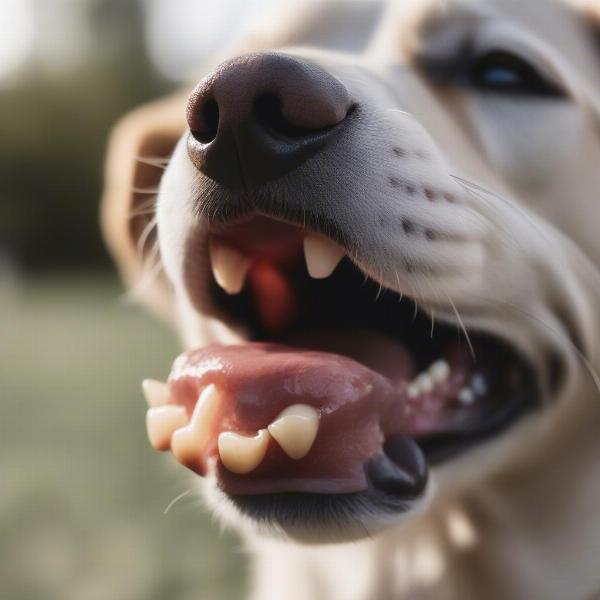Tooth pain in dogs can be a subtle yet serious issue. It’s often difficult to tell when our furry friends are experiencing dental discomfort, as they can’t verbally express their pain. Understanding the symptoms of tooth pain in dogs is crucial for early diagnosis and treatment, preventing more serious complications. This article will guide you through recognizing the signs, exploring potential causes, and outlining treatment options for tooth pain in your canine companion.
Recognizing the Subtle Signs of Tooth Pain in Dogs
 Dog Showing Tooth Pain Symptoms
Dog Showing Tooth Pain Symptoms
Dogs are masters of disguising pain, and dental discomfort is no exception. While some dogs may exhibit obvious signs, others might subtly alter their behavior. Look out for these telltale symptoms:
- Changes in Eating Habits: Difficulty chewing, dropping food, favoring one side of the mouth, or a complete loss of appetite can indicate tooth pain. Is your dog suddenly hesitant to eat their favorite crunchy treats? This could be a red flag.
- Excessive Drooling: While some drool is normal, a sudden increase in drooling can be a sign of oral discomfort.
- Pawing at the Mouth: If your dog is frequently pawing or rubbing their face, they might be trying to alleviate pain in their mouth. Are they rubbing their face against furniture more than usual? This could be a sign.
- Bad Breath: While not always indicative of pain, persistent bad breath can be a sign of underlying dental issues that may be causing discomfort.
- Swollen or Red Gums: Take a peek inside your dog’s mouth. Red, inflamed, or bleeding gums are a clear indicator of potential dental problems and pain.
- Reluctance to Play with Toys: If your dog is usually enthusiastic about their chew toys but has suddenly lost interest, tooth pain could be the culprit.
- Whining or Whimpering: While not specific to tooth pain, whining, especially when eating or touching the mouth area, could indicate discomfort.
- Facial Swelling: In more severe cases, facial swelling can occur, especially around the affected tooth.
Common Causes of Tooth Pain in Dogs
Understanding the potential causes of tooth pain can help you take preventative measures. Some of the most common causes include:
- Periodontal Disease: This is the most prevalent dental problem in dogs, caused by plaque and tartar buildup, leading to gum inflammation, tooth loss, and pain.
- Fractured Teeth: Chewing on hard objects can lead to chipped or broken teeth, exposing the sensitive pulp and causing significant pain.
- Abscessed Teeth: An infection at the root of a tooth can create a painful abscess.
- Retained Baby Teeth: Sometimes, puppy teeth don’t fall out as they should, leading to crowding, misalignment, and pain.
- Gingivitis: Inflammation of the gums can be painful and is often a precursor to periodontal disease.
Treatment Options for Tooth Pain in Dogs
If you suspect your dog is experiencing tooth pain, it’s crucial to consult a veterinarian. They will diagnose the underlying cause and recommend appropriate treatment, which may include:
- Dental Cleaning and Scaling: This professional procedure removes plaque and tartar buildup, helping to prevent and treat periodontal disease.
- Tooth Extraction: Severely damaged or infected teeth may need to be extracted to alleviate pain and prevent further complications.
- Antibiotics: In cases of infection, antibiotics are prescribed to combat the bacteria.
- Pain Medication: Your vet can prescribe pain relievers to manage your dog’s discomfort.
- Dental Chews and Toys: These can help to mechanically remove plaque and tartar, promoting good oral hygiene. why do dogs rub their face
- Dental Diets: Specially formulated diets can help to reduce plaque and tartar buildup. can dogs have condensed milk
Conclusion
Tooth pain in dogs can significantly impact their quality of life. By being aware of the symptoms, understanding the potential causes, and seeking prompt veterinary care, you can help your furry friend maintain a healthy and pain-free mouth. Don’t ignore the subtle signs; early intervention is key to preventing more serious dental problems. dog lost canine tooth
FAQ
- How can I prevent tooth pain in my dog? Regular brushing, dental chews, and professional cleanings are essential for preventing dental problems. double canines in dogs
- Is it safe to give my dog human pain medication? No, never give your dog human pain medication. Many are toxic to dogs and can have severe consequences.
- How often should my dog have their teeth professionally cleaned? This depends on the individual dog, but generally, annual cleanings are recommended.
- Can I brush my dog’s teeth at home? Yes, brushing your dog’s teeth regularly is one of the best ways to prevent dental disease.
- What kind of toothbrush should I use for my dog? Use a toothbrush designed specifically for dogs, which have softer bristles and are angled to reach the back teeth.
- What toothpaste should I use for my dog? Never use human toothpaste. Use a toothpaste specifically formulated for dogs, which is safe for them to swallow. water additive for dogs dental
- What are the signs of a serious dental infection in my dog? Facial swelling, lethargy, fever, and difficulty eating can all indicate a serious dental infection.
ILM Dog is your trusted resource for all things dog-related. We offer expert advice on dog breeds, health, training, nutrition, grooming, and much more. We’re committed to providing high-quality, practical information to help you care for your canine companion. Contact us today for personalized guidance on dog care products and accessories. Email: [email protected], Phone: +44 20-3965-8624. ILM Dog understands the importance of your dog’s dental health, and we are here to support you.